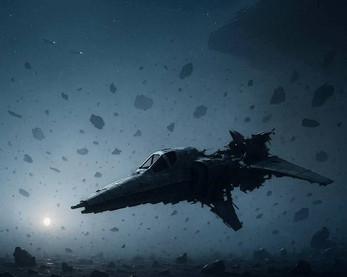Shooting Stars: Speeding to Oblivion
A downloadable book
A tactical starfighter mini-wargame where elite pilots battle in collapsing space while the real war unfolds elsewhere.
Every move you make matters.
None of it changes the outcome.
Roll dice. Burn fuel. Lose slowly.
Includes:
-
Tactical rules for doomed space combat
-
A full scenario (Gate Runner) with terrain degradation and stress mechanics
-
An essay on systematic futility as design philosophy
For solo reflection, two-player skirmishes, or group disillusionment
Forget glory. Embrace the futility. Welcome to the only honest dogfight in town.
A Parable for Our Times
Gate Runner maps perfectly onto modern civic engagement: organize marches, vote, petition - watch policy determined by forces operating at scales individual action can't address. The NERVE system becomes activist burnout. Zone degradation becomes media cycles and systematic disinformation. Strategic Annihilation becomes climate change, economic collapse, or any crisis that renders tactical victories strategically meaningless.
We've accidentally created a democracy simulator that's honest about systematic powerlessness disguised as individual agency.
"Individual activism is temporary. Systematic capture is permanent."

| Updated | 1 hour ago |
| Published | 2 days ago |
| Status | Released |
| Category | Book |
| Author | hotel.kilo |
| Tags | anti-power-fantasy, Experimental, Narrative, political, Print & Play, sad, Sci-fi, Tabletop, Tactical |

Comments
Log in with itch.io to leave a comment.
Shooting Stars – A Study in Systematic Futility
This briefing summarizes the core themes, mechanics, and philosophical underpinnings of Shooting Stars: Speeding to Oblivion, a tactical starfighter game that challenges traditional notions of player agency and heroic narratives.
I. Core Premise: Systematic Futility and the Irrelevance of Individual Heroics
The central, defining characteristic of Shooting Stars is its deliberate rejection of the "heroic gaming" paradigm. Unlike most tactical games that promise "agency in exchange for engagement, meaning in return for mechanical mastery," Shooting Stars is "designed to be rigged against meaningful victory, where individual heroics are systematically punished and tactical superiority becomes a liability for survival." This is not accidental unfairness but "intentional philosophical design."
The game's fundamental thesis, articulated directly, is that "individual heroics are temporary, systematic violence is permanent." This isn't mere flavor text; it's the mechanical reality that dictates outcomes. Player skill and tactical decisions have immediate consequences and provide "mechanical satisfaction of tactical agency," but ultimately, "systematic forces arrive to render all of that agency strategically irrelevant."
II. Key Mechanical Elements Reinforcing Systematic Futility
Several game mechanics are designed to undermine traditional notions of player empowerment:
III. The "Rigged Game" and the Paradox of Engagement
Shooting Stars openly admits to being a "rigged game," posing the question: "if the game is rigged and individual agency is illusory, why play at all?" The answer lies in its nature as "experiential philosophy." Players don't play to win, but "to experience the psychology of systematic futility in a controlled, repeatable format."
IV. Victory Conditions and Their Philosophical Implications
The victory conditions in Shooting Stars reflect its fatalistic philosophy:
V. Conclusion: The Point of Pointlessness
Shooting Stars challenges players to move beyond conventional gaming expectations. The point of the game is not to achieve a traditional victory, but to gain "clarity about their actual position within systematic structures—not the protagonists of their own heroic narratives, but participants in systematic processes larger than individual agency can meaningfully address."
As the designer's note concludes: "The dice don't care. The zones don't care. The strategic annihilation timer doesn't care. And that, precisely, is the point." The true "victory" is "not triumph over systematic forces, but recognition of systematic forces. Not empowerment through competence, but understanding through authentic powerlessness."
What is the core philosophy behind "Shooting Stars: Speeding to Oblivion"?
"Shooting Stars" fundamentally rejects the common gaming promise that individual skill and tactical acumen guarantee victory. Instead, its core thesis is that "individual heroics are temporary, systematic violence is permanent." The game is intentionally designed to be "rigged" against meaningful individual triumph, with overwhelming strategic forces ultimately determining outcomes regardless of player actions. This isn't about accidental unfairness but a deliberate philosophical design aiming to provide an "experiential philosophy" of powerlessness within systematic structures.
How do game mechanics in "Shooting Stars" reinforce its philosophical design of "systematic violence"?
Various mechanics in "Shooting Stars" are specifically crafted to highlight the futility of individual actions against larger forces. Zone degradation systematically removes safe areas, forcing pilots into increasingly dangerous environments. The "Strategic Annihilation" timer introduces an unavoidable, cosmic-scale threat that cannot be countered by tactical play. The "Nerve" system models psychological pressure, making even skilled pilots less effective as stress mounts. Even the objective "reality" of scenarios, like in "Gate Runner," explicitly states that fighter actions are "irrelevant" to the true outcome, which is dictated by external strategic events. These elements collectively underscore that individual competence is structurally insufficient.
What is the significance of the "rigged" nature of "Shooting Stars" and its departure from traditional game design?
"Shooting Stars" deliberately deviates from traditional game design's obsession with balance and fair opportunities for success. It features asymmetric advantages, where one side (Blue Squadron) might win tactical engagements 86% of the time under ideal conditions. However, this tactical dominance is intentionally rendered meaningless by the systematic pressures. The game's "rigged" nature is its "honesty," refusing to offer false comfort or disguise its predetermined structural outcomes. It doesn't promise that skill triumphs but instead aims to teach players to "get real" about the limits of individual agency in the face of overwhelming systematic forces.
How does "Shooting Stars" resolve combat and movement within its system?
Combat in "Shooting Stars" is resolved through opposed PILOT rolls, where the attacker and defender both roll 2d6 plus their PILOT attribute and any modifiers, with the higher roll winning. Ties favor the defender. A hit removes one hull point. Movement between "engagement zones" requires THRUST checks, with difficulty increasing based on the number of zones moved. Failing a THRUST check means the starfighter remains in its current zone. These mechanics govern the immediate tactical actions of individual starfighters.
What role do "Nerves" play in a pilot's performance and the game's overall design?
The "Nerve" attribute and associated "NERVE Checks" are crucial for simulating psychological resilience. After every starfighter action, a pilot must make a NERVE check (2d6 + NERVE vs. 8+). Failing a check moves the pilot down a "Status Track" (Operational, Rattled, Spooked, Breaking Down, Bugged Out), incurring cumulative penalties to all future rolls. This system directly ties pilot effectiveness to their psychological state, demonstrating how systematic stress erodes individual competence and can lead to a pilot's removal from the game, even without taking hull damage.
How are different types of zones and environmental conditions integrated into gameplay?
"Shooting Stars" features various engagement zones, each with unique effects. "Open Space" has no special effects, while "Debris/Asteroid Fields" require a PILOT check to avoid taking hits. "Point Defense Fire" zones have a chance to inflict random hits. "Capital Ship" zones combine both Debris Field and Point Defense effects, making them highly dangerous. Environmental conditions, such as "Sensor Jamming" (-1 to PILOT rolls) and "Communication Breakdown" (negating the Squadron Leader perk), further add layers of systematic challenge, impacting all participants regardless of individual skill.
What are the different victory conditions in "Shooting Stars," and which one is presented as the "reality"?
The game outlines several victory conditions: "Tactical Success" (eliminating the enemy squadron before the strategic threat arrives), "Pyrrhic Survival" (escaping with survivors when the strategic threat arrives), "Strategic Failure" (failing objectives and being eliminated), and "Systematic Annihilation" (everyone eliminated by the strategic threat). However, the "Reality" objective explicitly states that the fighter actions are "irrelevant" to the battle's true outcome. In the "Gate Runner" scenario, despite Blue achieving Tactical Success by eliminating Red, the battle station's arrival ultimately determines the true "Pyrrhic Survival" outcome, with the strategic mission completed by external forces, rendering the fighter engagement strategically meaningless.
How does "Shooting Stars" encourage player engagement despite its design philosophy of futility?
The "paradox of engagement" is central to "Shooting Stars." Players engage not to win in a conventional sense, but to "experience the psychology of systematic futility." The game provides mechanical satisfaction through dice rolls and tactical decisions, creating a tension between immediate agency (their actions matter in the short term) and ultimate irrelevance (their success doesn't alter the inevitable strategic outcome). This makes the game an "experiential philosophy" or "philosophical parable," where the mechanics serve as a vehicle for psychological insight into individual agency within overwhelming systematic structures, pushing players beyond traditional heroic narratives.